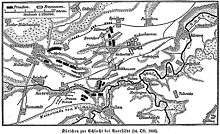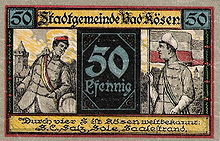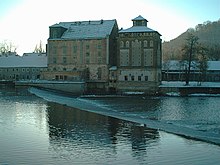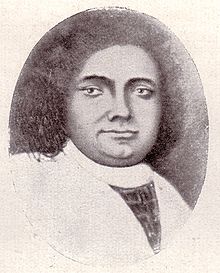Bad Kosen
|
Bad Kosen
City of Naumburg (Saale)
|
|
|---|---|
| Coordinates: 51 ° 8 ′ 7 ″ N , 11 ° 43 ′ 14 ″ E | |
| Height : | 115 m above sea level NN |
| Area : | 35.72 km² |
| Residents : | 5177 (Dec. 31, 2008) |
| Population density : | 145 inhabitants / km² |
| Incorporation : | January 1, 2010 |
| Postal code : | 06628 |
| Area code : | 034463 |
|
Location of Bad Kösen in Naumburg (Saale)
|
|
Bad Kösen (until 1935 Kösen ) is a district of the city of Naumburg (Saale) in the Burgenland district in Saxony-Anhalt . It is a sol bath and state-approved spa .
geography
Geographical location
Bad Kösen is located in the middle of Germany's northernmost quality wine -growing region, Saale-Unstrut, on the B 87 ( Via Regia ) between Apolda and Naumburg (Saale) in the Saale-Unstrut-Triasland Nature Park , about 40 km southwest of Halle and about 30 km northeast of Jena .
The city is traversed by the Saale , which has dug its bed deep in the limestone at the Kösener gate . The city divides around the Saale bridge into an Altkösen on the right of the Saale and younger Neukosen on the left of the Saale.
Local division
The following districts are part of Bad Kösen:
- Tultewitz (since 1993)
- Slide (1993)
- Hassenhausen (1992)
- Punschrau (1992)
- Small Herring (1991)
- Roedigen (1991)
- Saaleck (1950)
- Stendorf (1950)
- Lengefeld
- School gate
- Kukulau
- Frankenau
Surroundings
Not far from the city are the much-sung ruins of Saaleck Castle and the Rudelsburg with the monuments of the Kösener Seniors Convents Association (KSCV) above the Kösener gate .
history
Kösen was founded in the High Middle Ages as the Cusne Vorwerk of the Pforta monastery. With the construction of the stone bridge over the Saale, the Via Regia also took the shorter route via Kösen. After the secularization of the Pforta Monastery in 1540, Kösen belonged to the Electoral Saxon Office of Pforta from 1543 to 1815 . Up until the 18th century, the site was of certain importance for rafting on the Saale. The salt extraction that began in 1730 became unprofitable around 1857 when salt could be extracted more cheaply in Staßfurt . So Kösen only remained to develop in a tourist direction. The battle of Jena and Auerstedt took place in 1806 partly in the districts bordering Thuringia in the Kösener district of Hassenhausen.
By the resolutions of the Vienna Congress Kosen came to Prussia and in 1816 the county Naumburg in the administrative district of Merseburg of the Province of Saxony assigned to the part of the site to the 1944th In 1848, the people's assembly in Kösen was one of the major popular assemblies of the year of the revolution in the beech hall in Kösen . The Kösener Vogelweiden were a regular summer meeting of Germanists in Kösen in the 19th century.
In 1868, Kösen was elevated to the status of a town in the sense of the town code of May 30, 1853, and on July 1 of the following year the previous district secretary in Naumburg, Heinrich Anton Mascher, was appointed first mayor.
Since about 1813 students of the Corps , initially only those from the surrounding Central German universities, have been meeting annually at Whitsun at the Rudelsburg . After reunification, this tradition was resumed in 1994. Kösen became the namesake of the umbrella organization Kösener Seniors Convents Association (KSCV), which was founded in 1848 and in which the corps of primarily traditional (non-technical) universities in Germany, Austria and Switzerland came together.
In 1929, the rail travel publication Beideits von Eisenbahnweg describes the passage through the town on a train from Berlin to Frankfurt / Main at kilometer 215 as follows:
“At the bottom of the Saale a rushing weir, above it on the left a graduation tower and on the mountain slope (right) pretty country houses. We are in Bad Kösen (4200 inh.) Thanks to its charming location and its brine springs, we are a popular health resort and short stay. The Kösener SC (Senior Citizens' Convention), the association of corps at German universities founded in 1855, meets here in July. "
In 1935 Kösen became a bathing resort and was allowed to use the Bad Kösen rating .
In the GDR, Bad Kösen successively used the official surnames Volkssolbad and Bad der Arbeiters .
On July 1, 1950, the previously independent municipality of Saaleck was incorporated.
Until December 31, 2007, Bad Kösen was the sponsoring municipality of the Bad Kösen administrative community , to which five other municipalities belonged. From the dissolution of the administrative community on January 1, 2008, Bad Kösen was considered a unified municipality .
Incorporation to Naumburg (Saale)
On April 22, 2007, a referendum and referendum took place, in which the incorporation into the city of Naumburg was rejected and a majority of voters spoke out in favor of the continued existence of the administrative community as a unified community.
The judgment of the Higher Administrative Court of Magdeburg on December 11, 2007, to allow the allocation of the Wethau Valley to that of the Wethautal for the rural communities of the spa town, but not for Bad Kösen itself, surprised everyone involved. This resulted in the dissolution of the Bad Kösen administrative community at the end of December 31, 2007. A judgment by the Higher Administrative Court had become necessary after the Wethautal administrative association had sued against the assignment.
On January 1, 2010, the previously independent town of Bad Kösen was incorporated into the town of Naumburg (Saale) together with the communities of Crölpa-Löbschütz , Janisroda and Prießnitz . The administrative community Wethautal was dissolved.
Town twinning
Since 1991 Nidda has been the twin town of Bad Kösen in Hessen . In honor of the partnership, a street was named after the twin town in the Kösener development area.
coat of arms
Until it was incorporated into Naumburg in 2010, Bad Kösen had its own coat of arms.
Blazon : “In blue, a slightly arched three-arched bridge made of black grooved silver stone blocks, the middle arch higher and further, the arches set with keystones, on a green wave shield base, in it 9 indicated waves, in the middle of the bridge a fallen, conical, green wicker basket, from it protruding silver cone of salt. "
Declaration of coat of arms: The bridge is the Saale bridge in Bad Kösen, the green wave shield with waves symbolizes the Saale as a sign of belonging to the "Green Heart of Germany", the salt basket indicates centuries of salt production.
Culture and sights
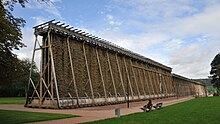
Buildings
- Graduation tower with a length of 325 meters
- Double articulated rods of the former saltworks from the Radinsel to the Borlachschacht, named after Johann Gottfried Borlach , who initiated the development of salt extraction in Kösen in 1730
- Brine shaft at the graduation tower
- Schulpforta Monastery
- The Romanesque House now contains the local museum and is a remnant of the medieval Cusne suburb , which at that time belonged to Schulpforta; the circumstances have thus been reversed. It is one of the oldest secular buildings in Central Germany.
- The Berghotel Wilhelmsburg as an exposed neo-Gothic secular building
- The neo-Gothic Luther Church from 1894 with an organ built by Wilhelm Rühlmann
- The Rudelsburg with its monuments in the Saaleck district
Museums
- Romanesque house , exhibition on the history of the Pforta monastery and salt production in Bad Kösen
- Kunsthalle The doll world of Käthe Kruse and the Wilhelm Bröker collection
Parks
Bad Kösen has three parks, including one in the city center with historic walk-in halls, a modern thermal bath, a zoo and two ponds. The park was still densely forested until 2005, when a windpipe in the middle of the year severely damaged around 30% of the tree population. A second, larger, artificially created spa park, called "Seekurpark", is located on the outskirts of the city on the hill between the B 87 and rehabilitation clinics. This spa park is used today for rehabilitation patients, but is open to the public. The third park is located around the graduation tower and is often used for events during the course season.
Villa and garden Schultze-Naumburg are part of the Network Garden Dreams Saxony-Anhalt .
Excursion traffic
Two motorboats run several times a day from the city center between April and October to the landing stage at the foot of the Rudelsburg.
Kösen and the Rudelsburg are located on the Feengrotten-Kyffhäuser-Weg , an old long-distance hiking trail , and on the Saale-Unstrut wine route with many ostrich taverns .
Sports
Bad Kösen has several regionally successful sports clubs, including a football club, the Blau-Weiß Bad Kösen e. V., and a tennis club. Both have their own sports fields. Canoe tours on the Saale are also possible. There is also a bowling club and a carnival club.
Regular events
- End of April: opening of the course season
- Beginning of June: Brunnenfest (festival in honor of Borlach and brine extraction)
- Wednesday to Saturday before Pentecost: Kösener Congress of the Kösener Seniors Convents Association , an umbrella organization of student corps , in the Courageous Knight
- Whitsun weekend: Wine mile on the left bank of the Saale from Bad Kösen to behind Naumburg
- Weekend after Whitsun: Meeting of the Rudelsburg Alliance in Saaleck
Wine
According to wine law, the Kösener Saale-Unstrut wines belong to the Neuchâtel Castle area , the Naumburg Göttersitz area .
The wines from the Pfortenser Köppelberg are recognized specialties. The Pforta Köppel mountain was as vineyard mentioned in 1147 for the first time and is the oldest mounting position of this wine region .
Other Kösener individual layers are Saalhäuser , Bad Kösener Schöne Aussicht and Klosterhäseler Hasseltal .
monument
The peace stones above the Ilskeweg are forgotten.
Economy and Infrastructure
economy
As a health resort, Bad Kösen houses several rehabilitation clinics. The Saale Rehabilitation Clinic I and II and the Children's Rehabilitation Clinic are operated by the Lielje Group from Löhne . The Burgenland Clinic is operated by medinet AG.
Käthe Kruse moved to Bad Kösen in 1912 and set up her doll manufacture there. In the GDR , this resulted in the Kösener toy factory . In the factory, which today mainly produces plush toys, not only realistic plush animals but also well-known licensed products are manufactured.
In 1952 two of Käthe Kruse's sons, including the children's book author Max Kruse , founded workshops in Bad Pyrmont and Donauwörth in the Federal Republic of Germany. She herself only withdrew from the now state-owned company in 1954 and went to the West.
The state winery Kloster Pforta is based in Bad Kösen.
The organ building company Heerwagen existed in Bad Kösen from 1893 to 1896 .
education
Bad Kösen currently has 2 schools, the mountain school ( elementary school ) and the Borlach school ( secondary school ). Until 2004, the Medical Education Institute had a vocational school in the city, but then moved with it to Weißenfels . High school students from Bad Kösen visit the Domgymnasium Naumburg . The Pforta state school , which is located in the former Schulpforte monastery, is also part of Bad Kösen. It is a boarding high school with a scientific, linguistic or musical orientation.
traffic
Bad Kösen is on the Halle – Bebra railway just before the junction of the Saalbahn to Saalfeld via Jena. With the commissioning of the high-speed lines Leipzig / Halle-Erfurt and Erfurt-Nuremberg , long-distance traffic was withdrawn by 2017, which passed Bad Kösen without stopping. This made it possible to expand regional traffic, so that in addition to the hourly regional train from Halle via Erfurt to Eisenach, there were also hourly regional trains to Leipzig and Jena, hourly express connections to Halle and Erfurt and every two hours to Jena. These are operated by Abellio Rail Mitteldeutschland and DB Regio Südost . Bad Kösen is part of the Central German Transport Association .
The central hall of the historic reception building of Bad Kösen station has been preserved, which was renovated in 2016-2018 and supplemented by a modern extension. Since then a waiting hall, a public toilet and a tourist information center have been available again. There are also bus stops and parking spaces in the immediate vicinity. Access to platform 2 should also be barrier-free by 2020.
The federal road 87 runs through Bad Kösen, it leads directly through the old town. There have been plans for the Bad Kösen and Naumburg (Saale) bypasses in the course of the B 87 for several years. There is building permission for the Bad Kösen bypass, and the planning approval procedure for the Naumburg bypass should be completed by 2013. Construction is not expected to start before 2015. With the two bypasses, the B 87 between Taugwitz and Wethau is to be re-routed. The Saale valley would be spanned between Großheringen and Saaleck by a 1200 m long new bridge on bridge piers up to 60 m high. However, this is rejected by critics who see it as a threat to the application for the UNESCO World Heritage status for the Saale-Unstrut region. In the course of the planning, the question of the extent to which the planned area monument of the Naumburg and Saale Valley World Heritage Site would result was not examined. There was no coordination with ICOMOS and UNESCO .
A special form of track-guided means of transport opens up the south-eastern streets near the train station (graduation house, health clinic): a non-moving passenger ferry on a track or suspension cable that is moved by muscle power with a mooring rod (or lever rod).
The Saale cycle path leads through Bad Kösen.
The ecumenical pilgrimage from Görlitz to Vacha leads through the integrated district of Punschrau .
Personalities

Honorary citizen
- O. Th. Rosenberger (1806-1893), bathing and miners' surgeon, secret medical council (appointed 1882)
- Ernst Roßner (1819–1893), mill owner (appointed 1891)
- Friedrich von Feilitzsch (1858–1942), princely. schaumburg-lippe minister of state (appointed 1895)
- Karl Müller (1820–1901), postmaster (appointed 1899)
- Max Kruse (1854–1942), sculptor (appointed 1924)
- Paul von Hindenburg (1847–1934), President of the Reich (appointed 1925)
Sons and daughters of the place
- Johann Ehrenfried Zschackwitz (1669–1744), historian and heraldist
- Albert Bösel (1834–1920), entomologist, botanist and school principal
- Georg Groddeck (1866–1934), pioneer of psychosomatics and writer
- Gottlieb Wagner (1794–1878), innkeeper of the Rudelsburg
- Georg Jüterbock (1892–1940), aviation pioneer
- Hans Fischerkoesen (1896–1973), animator and commercial filmmaker
- Max Kruse (1921–2015), children's book author
- Klaus-Dieter Fichtner (* 1929), educator and local history expert
- Ulrich Baehr (* 1938), painter
- Hans-Jochen Schmidt (* 1947), diplomat
People related to the place
- Johann Gottfried Borlach (1687–1768), electoral Saxon mountain ridge
- Ferdinande von Schmettau (1798–1875), symbolic figure and folk heroine during the wars of liberation against Napoleon
- Frederick Klaeber (1863-1954), Anglist whose research focus of Beowulf was
Well-known spa guests
Bad Kösen attracted musicians, writers, artists and great intellectuals. The painters Adolph Menzel and Max Liebermann looked for and found their Thuringian motifs here, the beech halls of the two are probably the best known. Edvard Munch cured from March 1906 to January 1907 in Kösen because of his nervous disorders. In addition to Thuringian landscapes, self-portraits and stage designs, the preparatory work for the “Reinhardt Frieze”, a commission from Max Reinhardt for the new Kammerspiele in Schumannstrasse 13a in Berlin, was made. The portrait of Friedrich Nietzsche (1906, Munch - museet , Oslo), which places the philosopher on the Rudelsburg, and his painting of the spa gardens in Bad Kösen also remind us of Munch's time in Kösen .
literature
- Kosen . In: August Schumann : Complete State, Post and Newspaper Lexicon of Saxony. 5th volume. Schumann, Zwickau 1818, pp. 20-24.
- August Constantin Ende: Kosen. Dorf, Saline, Bad (= Thuringia and the Harz , Bd. 8). Published by Friedrich August Eupel, Sondershausen 1845.
- A. Reinstein, C. Sander: Kosen . Cursch, Naumburg 1848 ( digitized version )
- Hugo Hagendorff : The Kösen Soolbad along with the banks of the Saal and the nearest cities: A guide for bathers , Berlin 1859 ( digitized )
- Leo Woerl (Ed.): Illustrated Guide through Bad-Kösen , 5th edition, Woerls Travel Guide Verlag, Leipzig 1914.
- Friedrich Hoppe : Bad Kösen, Heimatliche Geschichtsbilder , published by the Magistrate of Bad Kösen, 1930.
- Lutz Toepfer: Memories of Kösen at the time the KSCV was founded . Once and Now, Yearbook of the Association for Corps Student History Research, Vol. 43 (1998), pp. 9–24.
- Thomas Budde: Cusne, Cosene, Cossen, Bad Kosen - from the monastery to the spa . Kulturbetriebsgesellschaft Bad Kösen (ed.). Bad Kosen 2008.
Web links
- Publications on Bad Kösen in the catalog of the German National Library
- Search for Bad Kösen in the German Digital Library
- Homepage of the Kur- und Tourismusverein Bad Kösen e. V.
Individual evidence
- ↑ Saaleck on www.genealogy.net
- ↑ Gottfried August Benedict Wolff: Chronicle of the Pforta monastery according to documentary reports . Vol. 1: From the foundation to 1223 . FCW Vogel, Leipzig 1843, p. 74.
- ^ Karlheinz Blaschke , Uwe Ulrich Jäschke : Kursächsischer Ämteratlas , Leipzig 2009, ISBN 978-3-937386-14-0 ; P. 34f.
- ↑ August Constantin Ende: Kösen. Village, saltworks, bath . Published by Friedrich August Eupel, Sondershausen 1845, pp. 28-29.
- ^ Locations of the Prussian district of Naumburg in the municipal directory 1900
- ↑ Thomas Budde: From the salt works to the brine spa. A historical summary . In: Johannes Mager (Hrsg.): On salty traces - cultural-historical forays. A history of people, saline technology and culture . Thomas Publishing House. Leipzig 2010, p. 105.
- ↑ Thomas Budde: From the salt works to the brine spa. A historical summary . In: Johannes Mager (Hrsg.): On salty traces - cultural-historical forays. A history of people, saline technology and culture . Thomas Publishing House. Leipzig 2010, p. 115.
- ↑ StBA: Area changes from January 01 to December 31, 2010
- ↑ Bad Kösens train station has been renovated. Mitteldeutscher Rundfunk, December 11, 2018, accessed on January 21, 2019 .
- ↑ Realize the Bad Kösen bypass quickly. Application by several members of the Saxony-Anhalt state parliament, May 29, 2012 (PDF; 73 kB)
- ↑ Effects of the construction project B 87 Bad Kösen on the high medieval cultural landscape cannot be assessed. Press release of the German Bundestag, March 15, 2011 ( Memento of December 29, 2012 in the Internet Archive )
- ^ Munch and Germany . Hamburg 1994; Pp. 201, 206




